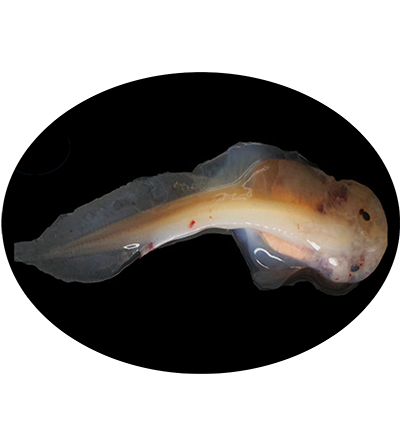
The Mariana snailfish or Mariana hadal snailfish Pseudoliparis swirei is a species of snailfish found in the Mariana Trench in the western Pacific Ocean. It is known from a depth range of 6,198–8,076 m,which is possibly the record for a fish caught on the seafloor. Various anatomical, physiological, molecular and genetic adaptions help this species survive in such depths. It is abundant in their deep-sea habitat and has several unusual adaptions for its dark and high pressure habitat, including transparent skin that lacks pigment, certain organs and eggs that are enlarged, the muscles are thinner, the ossification of its bones (notably the skull) is incomplete.
Animalia (Kingdom); Chordata (Phylum); Vertebrata (Subphylum); Gnathostomata (Infraphylum); Osteichthyes (Parvphylum); Actinopterygii (Gigaclass); Actinopteri (Superclass); Teleostei (Class); Perciformes (Order); Cottoidei (Suborder); Liparidae (Family); Pseudoliparis (Genus); Pseudoliparis swirei (Species)
Pseudoliparis swirei Gerringer & Linley, 2017
1. Gerringer M E, Linley T D, Jamieson A J, et al. Pseudoliparis swirei sp. nov.: a newly-discovered hadal snailfish (Scorpaeniformes: Liparidae) from the Mariana Trench[J]. Zootaxa, 2017, 4358(1): 161–177-161–177. (Gerringer et al., 2017)
Holotype is immature. Ripe females had eggs up to 9.4 mm diameter, among the largest teleost eggs recorded, 0.4 mm smaller than the largest record. The eggs were unsorted within gonad, with the largest eggs free and interspersed within a matrix of smaller eggs. No developmental structures were visible within even the largest eggs. Two distinct size classes of eggs present with up to 23 large eggs (>5 mm) and up to 851 small eggs of less than half the diameter of the larger size class. There were rarely intermediate stages (Figure 7). Individuals with only small eggs had maximum egg sizes ranging from 0.7 to 1.4 mm. Genital papilla visible in freshly collected males, oriented anteriorly
The Mariana Trench famously houses the ocean’s deepest point, at Challenger Deep, named for the HMS Challenger expedition which discovered the trench in 1875. Their deepest sounding of 8,184 m, then the greatest known ocean depth, was christened Swire Deep after Herbert Swire, the ship’s First Navigating Sublieutenant (Corfield 2003). We name this fish in his honor, in acknowledgment and gratitude of the crew members that have supported oceanographic research throughout history
Known only from the Mariana Trench at capture depths from 6,898–7,966 m, individuals likely this species were recognized in video at depths 6,198–8,098 m
| Species | Phylum | Common Name | Ecosystem | Depth | Habitat | NCBI Taxonomy ID |
|---|---|---|---|---|---|---|
| Pseudoliparis swirei | Chordata | hadal snailfish | Deep sea | 7,254 | the Mariana Trench (142°26′E, 11°07′N) | 2059687 |
| Genome Assembly | Genome Size | Assembly level | Released year | WGS accession | Submitter | BioProject | BUSCO completeness (%) | Scaffold/Contig N50 (kb) | GC content (%) | Repeat Rate (%) | Gene Number |
|---|---|---|---|---|---|---|---|---|---|---|---|
| NWPU_hadal_v1 | 626.4Mb | Chromosome | 2023 | JANBZZ01 | Northwestern Polytechnical University | PRJNA852951 | 96.00 | 25,738/4,219 | 44 | - | 21,161 |
| Title | Journal | Pubmed ID |
|---|---|---|
| Chromosome-level genome assembly of hadal snailfish reveals mechanisms of deep-sea adaptation in vertebrates | Elife | 38134226 |
| Gene ID | Description |
|---|---|
| HS10851 | C21ORF13-RELATED |
| HS10852 | PROTEIN FAM167A |
| HS10853 | CEREBRAL CAVERNOUS MALFORMATIONS PROTEIN 2 HOMOLOG |
| HS10854 | XK-RELATED PROTEIN |
| HS10855 | MYOTUBULARIN-RELATED |
| HS10856 | L-THREONINE 3-DEHYDROGENASE |
| HS10857 | G PATCH DOMAIN CONTAINING PROTEIN |
| HS10858 | SOX TRANSCRIPTION FACTOR |
| HS10859 | TYROSINE-PROTEIN KINASE |
| HS10860 | FIBRONECTIN TYPE III DOMAIN-CONTAINING PROTEIN |
| HS10861 | PHOSPHOTYROSINE INTERACTION DOMAIN-CONTAINING FAMILY MEMBER |
| HS10862 | RBR FAMILY RING FINGER AND IBR DOMAIN-CONTAINING |
| HS10863 | ZINC FINGER AND BTB DOMAIN-CONTAINING |
| HS10864 | SORTING NEXIN 17 AND 27 |
| HS10865 | ALL-TRANS RETINOIC ACID-INDUCED DIFFERENTIATION FACTOR |
| HS10866 | TRANSLATION INITIATION FACTOR EIF-2B |
| HS10867 | NUCLEOSIDE DIPHOSPHATE KINASE 6 |
| HS10868 | BRAIN AND ACUTE LEUKEMIA CYTOPLASMIC PROTEIN |
| HS10869 | |
| HS10870 | NEUROTRANSMITTER GATED ION CHANNEL |
| HS10871 | FERM AND PDZ DOMAIN-CONTAINING PROTEIN FAMILY MEMBER |
| HS10872 | BCL-2-MODIFYING FACTOR |
| HS10873 | ZINC FINGER CCCH DOMAIN-CONTAINING PROTEIN 14 |
| HS10874 | FOS TRANSCRIPTION FACTOR-RELATED |
| HS10875 | MAJOR FACILITATOR SUPERFAMILY PROTEIN-RELATED |
| HS10876 | TGF-BETA FAMILY |
| HS10877 | KNIRPS-RELATED PROTEIN-RELATED |
| HS10878 | YLP MOTIF CONTAINING PROTEIN NUCLEAR PROTEIN ZAP |
| HS10879 | HOMEOBOX PROTEIN PROSPERO/PROX-1/CEH-26 |
| HS10880 | DIHYDROLIPOYLLYSINE-RESIDUE SUCCINYLTRANSFERASE COMPONENT OF 2-OXOGLUTARATE DEHYDROGENASE COMPLEX, MITOCHONDRIAL-RELATED |
| HS10881 | FOS TRANSCRIPTION FACTOR-RELATED |
| HS10882 | FOS TRANSCRIPTION FACTOR-RELATED |
| HS10883 | FOS TRANSCRIPTION FACTOR-RELATED |
| HS10884 | TRANSMEMBRANE EMP24 DOMAIN-CONTAINING PROTEIN |
| HS10885 | TRANSLATION INITIATION FACTOR EIF-2B SUBUNIT BETA |
| HS10886 | UNCHARACTERIZED |
| HS10887 | VISUAL SYSTEM HOMEOBOX 2 |
| HS10888 | ACETYL-COENZYME A SYNTHETASE |
| HS10889 | ATP-BINDING CASSETTE, SUB-FAMILY D MEMBER |
| HS10890 | SPHINGOSINE-1-PHOSPHATE PHOSPHOHYDROLASE |
| HS10891 | VOLTAGE AND LIGAND GATED POTASSIUM CHANNEL |
| HS10892 | TRANS-3-HYDROXY-L-PROLINE DEHYDRATASE |
| HS10893 | FORMIN HOMOLOGY 2 FAMILY MEMBER |
| HS10894 | APOPTOSIS-STIMULATING OF P53 PROTEIN |
| HS10895 | APRATAXIN-RELATED |
| HS10896 | APRATAXIN-RELATED |
| HS10897 | NUCLEOLAR PROTEIN 7/ESTROGEN RECEPTOR COACTIVATOR-RELATED |
| HS10898 | TRANSCRIPTION FACTOR GATA FAMILY MEMBER |
| HS10899 | FARNESYL-DIPHOSPHATE FARNESYLTRANSFERASE |
| HS10900 | CYSTEINE PROTEASE FAMILY C1-RELATED |

